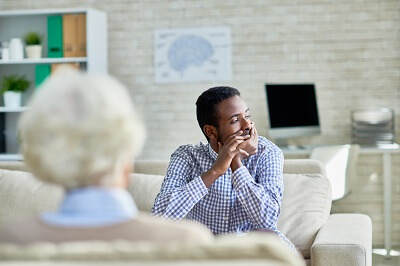The Importance of Positioning of the Therapist and Client
Where the power lies in the therapist-client relationship Surely it is the nature of the relationship that is the crux. For example a female client with a violent history with men may be best supported by a female counselor.

What Is Your Client S Body Language Telling You
Position your clients so that the part of their body you want to work on is directly in front of you close to your body and facing up toward you.

. This can erode trust. If you dont or cant put your trust in them. There is a good deal written about the role of the therapist but less about the clients.
But surprisingly the clients role is of central importance for the positive outcome of therapy. 2 Some research in this area has gone so far as to suggest that most of the variance in outcome is a result of. Assuming that their therapist is both competent and conscientious.
That of analyst and. If a therapist is not positioned correctly they can suffer from injuries such as repetitive strain injury when carrying out a treatment that has nail art keeping repetitive motions like filing to a. In sum research supports the importance of a compatible therapistclient match as a predictor of therapeutic success Bernier Dozier 2002.
State the importance of positioning yourself and the client correctly throughout the treatment Correct posture enables you to work longer and prevents muscle fatigue aches and pains. Now its normal to put up walls when you first enter therapybut its your therapists job to break them down gain your. Being a real and genuine person within the relationship can further enable work at relational depth.
Meditation validation exercises. More explicitly the study found that differences in rater perspective were important with therapists positive quality of life ratings having a trivial impact on their clients view of the working alliance. The formation of a secure attachment to the therapist has been shown to be significantly associated with greater reductions in client distress.
In other words its hard to benefit from therapy if you and your therapist dont get along. The position favoring similarity appears to have evolved from observations that therapist and client demographic and personality characteristics such as gender race personality and mental health have a profound impact on psychotherapeutic process and outcome. For clients perhaps the single most valuable function of therapy is the unprecedented freedom of expression it affords them.
When working with positioning it is possible to provide clients with stability and comfort which will leave them calmer and more relaxed. It is nearly always possible to find a position that is comfortable for the client and also allows you to maintain your body in as near to a neutral posture as possible as you work. However even if the therapist.
Although I am told this is so becuase it allows the clients to visually search for thoughts avoids the therapist looking as though ther are staring at the client and allows for a natural and physical point of exit in the room. Rather than face to face which is deemed more restrictive and ther is a lesser point of entry or exit. It is also possible to position clients in ways that make certain procedures easier for the caregivers eg.
An essential element to a successful therapy journey is a positive therapist-client relationship. The Importance of the Relationship With the Therapist. However research over the past fifty years has demonstrated that one factor more than any other is associated with successful.
This position should enable the therapist to shift the body weight backwards and forwards or from side to side. Proper egronomics would also mean higher efficiency and. Manage your own emotions.
If you dont click. A good rule of thumb is to work only on the parts. State the importance of the position of the therapist and the client during a waxing treatment.
Of key importance is how the therapist and client connect collaborate and experience one another during therapy. Why Positioning is Important. Commit to managing your own emotions.
Research shows that many factors affect whether treatment is successful including the severity of the problems being treated the patients belief that the counseling will work and the skill level of the therapist. It should also allow for a coordinated action between the body and the hands during the massage movement. Explain the importance of positioning yourself and the client correctly throughout the treatment.
So let us understand your role in a therapy session. If the therapist responds in an attuned way the client will have a positive experience which may encourage her to also express needs outside of the therapy room. To ensure that the client is comfortableTo make sure that no.
Research shows that the therapeutic relationship is one of the strongest predictors of successful treatment Before beginning psychotherapy most patients wonder Will this counseling really help me with my problems Research shows that many factors. This indicates that therapists quality of life influences the way they relate to their clients in the therapy room. A good posture is therefore one in which the therapist feels well-grounded whilst having the freedom to move.
The importance of the therapeutic relationship cannot be overlooked. No matter the situation these factors play a huge part in recovery. It forms the foundation of all counselling work.
The client or therapist relationship is often different to any other because of this. When a client wont open up therapists may feel anxious before therapy. Research supports that 40-75 of the outcome of therapy depends on the client variables.
The client should feel relaxed and comfortable when the treatment is being carried out. Engagement and sharing of information during the counselling process is also crucial as the client-therapist relationship can only establish a successful result and outcome through a positive and mutual collaboration underpinned by. By experiencing a secure attachment with the.

Goodtherapy The Power Differential And Why It Matters So Much In Therapy

Why Are Client Therapist Relationships So Important

Massage Contraindications Explored By Rachel Fairweather Massage Massage Training Massage Therapist

Chapter 7 Assessing Client Preferences And Adjusting Counselling Style Fostering Responsive Therapeutic Relationships
No comments for "The Importance of Positioning of the Therapist and Client"
Post a Comment